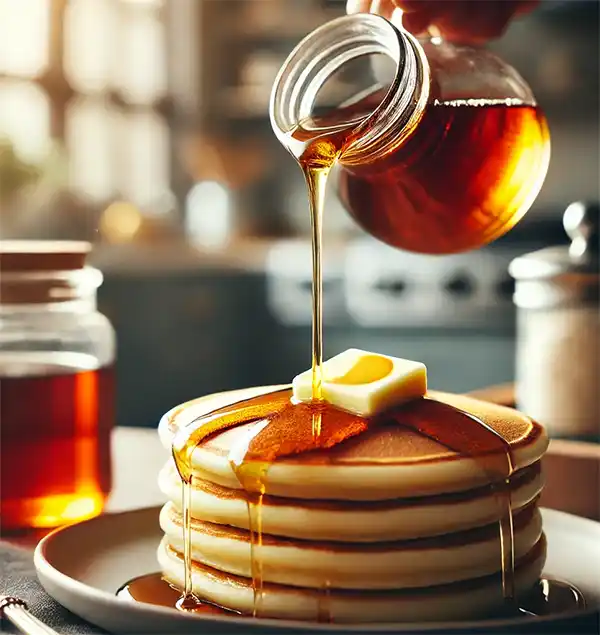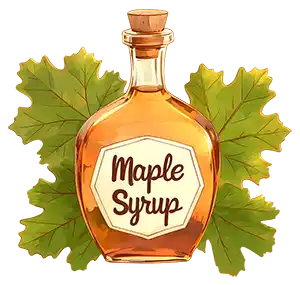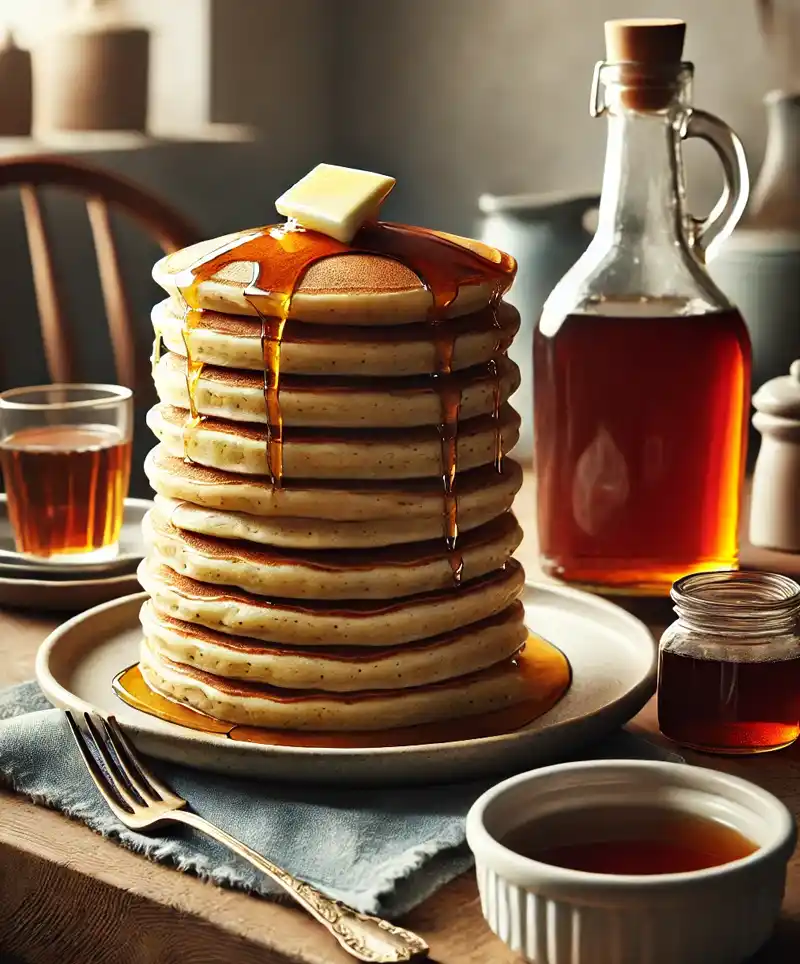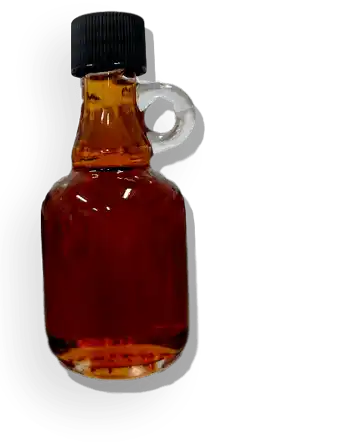A Sweet Celebration
Every year on December 17th, we gather around pancakes, waffles, and French toast to celebrate the sticky, golden delight that is maple syrup. National Maple Syrup Day isn’t just a day to drizzle a little extra on your breakfast—oh no, it’s a full-blown ode to one of nature’s sweetest miracles. Grab your syrup jug, and let’s dive into the delicious history, production, and peculiarities of this liquid gold.
A Sweet History
Maple syrup has a history as rich as its taste. Native Americans were the first to discover that the sap of the sugar maple tree could be boiled down into syrup. According to legend, one particularly observant chief noticed sap dripping from a tree and decided to taste it, discovering a sweetness unlike anything he’d encountered before. Soon, boiling the sap became a common practice, and maple syrup found its way into everything from savory dishes to desserts.
When European settlers arrived, they quickly adopted this delicious discovery, refining the techniques and spreading the practice across the continent. By the 1700s, maple syrup production was an essential part of many communities, especially in regions with long winters and an abundance of sugar maple trees. It wasn’t just a tasty treat; it was also a necessity. In the days before refined sugar became widely available, maple syrup and maple sugar were essential sweeteners for baking and cooking.
During the 19th century, maple syrup even became a symbol of independence. Many abolitionists promoted the use of maple syrup over cane sugar, which was often harvested using enslaved labor. Choosing maple syrup was seen as both a moral and patriotic act—an early example of conscientious consumerism.
Today, maple syrup is most famously associated with Canada, which produces over 70% of the world’s supply. Quebec alone churns out millions of gallons each year, and the maple leaf has become a national symbol. But the United States also has its share of syrup-producing regions, including Vermont, which takes fierce pride in its maple syrup traditions.
Modern advancements have made syrup production more efficient, but the heart of the process remains unchanged. It still takes about 40 gallons of sap to produce one gallon of syrup, and each drop is a testament to the hard work of farmers and the generosity of sugar maple trees. Whether drizzled on pancakes or used as a glaze for roasted vegetables, maple syrup continues to be a sweet staple in kitchens worldwide.
Sap to Syrup
The process of making maple syrup is simple in theory but labor-intensive in practice. Here’s how it goes:
- Tap the Trees: Sugar maple trees are tapped in late winter or early spring when the days are warm, and the nights are freezing. The sap flows out like nature’s soda fountain.
- Collect the Sap: In the old days, buckets were hung from trees, but modern producers use networks of tubing that make the forest look like a high-tech spider web.
- Boil It Down: It takes about 40 gallons of sap to make just one gallon of syrup. That’s right—most of the liquid is boiled off in what can only be described as a steamy labor of love.
- Grade It: Contrary to popular belief, maple syrup grades don’t indicate quality but rather color and flavor. Fancy terms like "Grade A Amber" or "Grade A Dark Robust" might sound like wine classifications, but they just reflect how bold the syrup’s flavor is.
The Great Pancake Debate
It's the eternal breakfast table debate: do you butter your pancake first and then add syrup, or pour the syrup on top and let it mingle freely with the butter? It might seem like a trivial question, but it’s one that has sparked countless arguments (and possibly a few pancake wars) at brunch tables worldwide.
 Those in the “butter first” camp argue that butter creates the perfect base layer, ensuring the syrup is evenly distributed without soaking into the pancake too quickly. They’ll tell you it’s a science, a delicate balance between creamy and sweet. Plus, butter lovers relish the way it melts into golden pools when topped with warm syrup—a scene straight out of a breakfast fantasy.
Those in the “butter first” camp argue that butter creates the perfect base layer, ensuring the syrup is evenly distributed without soaking into the pancake too quickly. They’ll tell you it’s a science, a delicate balance between creamy and sweet. Plus, butter lovers relish the way it melts into golden pools when topped with warm syrup—a scene straight out of a breakfast fantasy.
Meanwhile, the “syrup first” crowd insists that syrup is the star of the show and should take center stage. Let the pancakes soak it all up, they say, because every bite should taste like a sugary cloud. Butter, in their view, is just a supporting act, and sometimes they even skip it altogether (gasp!).
Then there are the chaotic neutral diners who opt for the “dip method.” These free spirits pour the syrup into a little side puddle, cutting their pancakes into neat slices and dunking each one. It’s the pancake equivalent of a fondue party—fun, messy, and unapologetically unorthodox.
Of course, let’s not forget the overachievers who add whipped cream, fruit, nuts, or chocolate chips into the mix. For them, pancakes are a canvas, and syrup is the brushstroke of sugary perfection. Butter or syrup first? Who cares—everything’s getting smothered anyway!
In the end, whether you’re a meticulous butterer, a reckless syrup pourer, or an avant-garde dipper, there’s no wrong way to enjoy pancakes. As long as they’re dripping with maple syrup, you’re winning the breakfast game. Pass the jug and let’s keep the debate alive—it’s just one more reason to have pancakes again tomorrow!
Fun Facts About Maple Syrup
Maple syrup isn’t just a sweet addition to your breakfast—it’s a treasure trove of quirky trivia that proves this amber nectar is more fascinating than it gets credit for. From its sticky connection to global politics to its unexpected roles in science, maple syrup has a resume that extends far beyond pancakes. Let’s dive into some fun and unexpected facts that’ll have you reaching for an extra drizzle of this liquid delight.
- Maple syrup was once used as a currency. Native Americans and early settlers used maple products in bartering systems. Imagine paying your rent in syrup—sweet deal!
- It has health benefits. Packed with antioxidants, zinc, and manganese, maple syrup is practically nature's multivitamin (though perhaps not FDA-approved).
- It’s denser than honey. A gallon of maple syrup weighs 11 pounds, making it heavier than a gallon of honey—more reason to lift syrup jugs for your bicep workout.
- Sap freezes in the tree. During winter, sugar maple sap essentially goes into cryo-sleep, storing its sweetness for the spring thaw.
- Maple syrup has its own grading system. The International Maple Syrup Institute developed global standards because syrup needs rules.
- You can smell it from space. Okay, not really, but the boiling process releases a heavenly aroma that fills entire towns during sugaring season.
- There’s a maple syrup diet. Beyoncé reportedly tried the "Master Cleanse" diet, which includes maple syrup, cayenne pepper, and lemon juice. This is not recommended unless you want to be hangry and sticky.
- Maple syrup has inspired science. Researchers have found that maple syrup extracts can enhance the effectiveness of antibiotics. It’s a sweet sidekick for science.
Clearly, maple syrup isn’t just another breakfast topping—it’s a fascinating, multi-talented marvel of nature!
Uses Beyond Breakfast
While maple syrup is the undisputed champion of breakfast condiments, its talents go far beyond the morning table:
- Glaze your meats. Maple syrup adds a smoky sweetness to bacon, ham, and roasted veggies.
- Cocktail hero. Swap out simple syrup for maple syrup in cocktails for a sophisticated twist.
- Desserts galore. Drizzle it over ice cream, mix it into whipped cream, or bake it into cookies for a gooey treat.
 Celebrating National Maple Syrup Day
Celebrating National Maple Syrup Day
On National Maple Syrup Day, you have full permission to go overboard. Start with pancakes, but don’t stop there—maple-glazed salmon for lunch, maple-candied pecans for a snack, and maple syrup in your coffee to fuel it all. If anyone questions your choices, remind them it’s a holiday and that moderation is for January.
Maple syrup is more than a sugary topping—it’s a tradition, an art, and a testament to nature’s ingenuity. So, on December 17th, raise your fork, raise your glass, or just raise a toast (literally, maple syrup goes great on toast) to this sticky, sweet, and utterly delightful gift from the trees.
And if you accidentally spill syrup on your table, don’t worry—it’s just your way of paying homage to the syrup gods.
Please Share our Content






 Those in the “butter first” camp argue that butter creates the perfect base layer, ensuring the syrup is evenly distributed without soaking into the pancake too quickly. They’ll tell you it’s a science, a delicate balance between creamy and sweet. Plus, butter lovers relish the way it melts into golden pools when topped with warm syrup—a scene straight out of a breakfast fantasy.
Those in the “butter first” camp argue that butter creates the perfect base layer, ensuring the syrup is evenly distributed without soaking into the pancake too quickly. They’ll tell you it’s a science, a delicate balance between creamy and sweet. Plus, butter lovers relish the way it melts into golden pools when topped with warm syrup—a scene straight out of a breakfast fantasy. Celebrating National Maple Syrup Day
Celebrating National Maple Syrup Day








 "Sláinte!" is a traditional Irish expression used as a toast, equivalent to "Cheers!" in English.
"Sláinte!" is a traditional Irish expression used as a toast, equivalent to "Cheers!" in English.